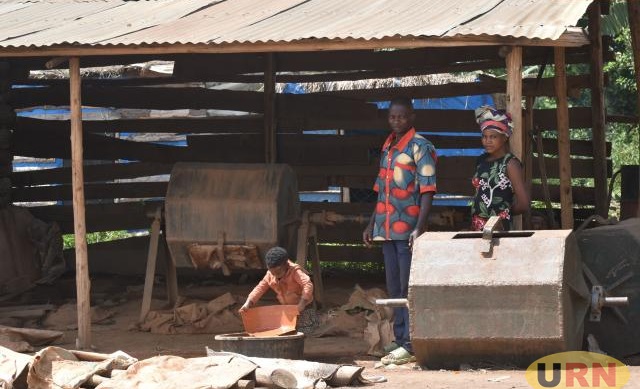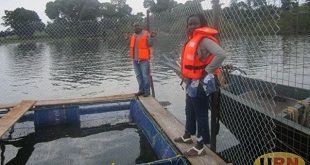
Kassanda, Uganda | THE INDEPENDENT | When 15-year-old Mukasa (not his real name), a native of Kyankwanzi district left school to seek a livelihood, he ended up working in the gold mines. Situated in Nkufa, Kassanda District, this gold mining, which began in the 1980s, perpetuates several illegalities, including child labor, the use of banned chemicals like mercury, and illegal mining practices, with unrecorded gold output.
Gold mined in Uganda, along with that smuggled from neighboring states, largely ends up in Middle Eastern countries, while mercury is illegally imported into the country. In Kassanda, gold mining has attracted not only Mukasa but also countless other children, some as young as him or even younger. Drawn to the mines, they hope to carve out a path to escape poverty.
“I dropped out of school. My parents had no money,” Mukasa said with a shy smile during an interview in December last year. “I came here to work and make money. I hope to earn enough to return home. I feel that one day, I will find ekibimba (a large gold nugget) and start a new life.”
While dreaming of a better future, Mukasa and his peers endure grueling tasks such as digging and hauling rocky soil from deep pits. They are also exposed to toxic chemicals and hazardous conditions. A report by Stop Child Labour, an international child rights organization, based on visits to three mining sites in Kassanda, revealed that 70–80% of workers in gold washing or panning areas were children.
Researchers observed approximately 1,000 to 1,200 children working across the three sites. Isaac Ssendi, an artisanal miner, justified the recruitment of child laborers, explaining that mine operators prefer hiring boys aged 12 to 17, locally referred to as tooto (a Swahili term for a young person). “They offer cheap labor compared to adults,” he said. “Besides being affordable, they are trustworthy and obedient—qualities essential in this business.”
However, the conditions faced by children like Mukasa are categorized as the worst forms of child labor by the International Labour Organisation (ILO). And despite hard work, the aspirations of these children are a pipe dream. Frank Jjuuko, an artisanal miner and businessman in Kassanda, explained that most workers, including children, are not paid in cash but receive a share of the soils they extract.
“Those who work in the pits, hauling soil, work for two days and are then given a basin of soil,” Jjuuko said. “Gold is processed from this soil. On a good day, one might find gold worth 100,000 shillings, but usually, they get only about 10,000 shillings—or nothing at all.”
Beyond mining, children also work in and around the mines selling food and drinks. During the reporter’s visit to Kassanda in December, two young girls, around 12 or 14 years old, were seen serving drinks in a makeshift shop. When asked about the appropriateness of children working in such an environment, a miner dismissed the concern, saying, “those girls are here with their aunt. Why do you care?”
Despite the visible presence of children, many supervisors deny their involvement. Charles Wamono, a supervisor at one of the sites, claimed that no young children were allowed to work. “Our rules don’t allow young children here,” he insisted. However, when pressed about the boys seen working nearby, he changed his explanation, saying, “these boys are local residents. They don’t do much—just simple tasks during school holidays.”
Efforts to curb child labor in the mines have yet to yield significant results. In 2017, international Civil Society Organizations, including Solidaridad, partnered with companies like Fairphone and Philips to launch the “Joint Forces to Tackle Child Labor—From Gold Mine to Electronics” project. The initiative aimed to combat child labor in mining.
Joshua Rukundo, a senior project officer at Solidaridad East and Central Africa, combating child labour in mines in Uganda is an ongoing effort. “While progress has been made, combating child labor in Uganda’s mines remains an ongoing challenge. It requires continuous collaboration, commitment, and innovative solutions to protect children and ensure their rights are upheld,” said Joshua Rukundo, Senior Project Officer at Solidaridad East and Central Africa.
Mercury Exposure
Despite its ban, mercury remains accessible to artisanal miners in Uganda. The situation in Kassanda is particularly dire. Our reporter witnessed a girl, no older than three, panning water-laden soils mixed with mercury as her parents stood by, smiling—unaware of the grave danger to which they were exposing their child.
Dr. Herbert Nabaasa, Commissioner for Environmental Health at Uganda’s Ministry of Health, who has done extensive research on mercury, says there are severe risks associated with mercury exposure. “Even small amounts of mercury can cause serious health problems, particularly for children. It affects the nervous, digestive, and immune systems and can lead to cognitive impairment, tremors, and neurological disorders,” he explained.
“The risk is even greater for unborn children and infants, whose exposure can result in developmental delays and cognitive dysfunction,” he added.
The Mining and Minerals Act of 2022 bans the use of hazardous chemicals like mercury. However, in Kassanda, mercury use and contamination are commonplace. Mercury-laden water used in gold extraction is often discharged into nearby swamps, polluting the environment and endangering community health.
Neither miners nor gold buyers wear protective equipment when burning the mercury-gold amalgam, a process that releases toxic mercury vapors and leaves behind small quantities of gold. Emmanuel Kibirige, National Coordinator of the Uganda Association of Artisanal and Small-Scale Miners (UGAASM) and a miner at Kagaba Hill in Bukuya, Kassanda, acknowledged the widespread use of mercury.
“Miners have mastered tricks to hide mercury from inspectors, including concealing it in their mouths,” Kibirige revealed.
Rose Nakawuma, Artisanal and Small-Scale Mining Associations and Cooperatives Officer at PlanetGOLD Uganda project, based in Kampala, says miners face a dilemma: despite the known dangers of mercury, its affordable, effective and there are no alternatives are unavailable.
“Miners continue using mercury because they have little choice,” she explained.
Kibirige echoed this, stating that alternative methods, such as leaching processes, remain prohibitively expensive for artisanal miners who often rely solely on physical labor as their capital.
In 2019, Uganda became the first country in the region to ratify the Minamata Convention on Mercury, an international treaty aimed at protecting human health and the environment from mercury. Following this, Uganda incorporated stringent measures into the National Environment Act and introduced regulations to manage hazardous chemicals. These measures effectively banned mercury.
However, mercury continues to enter Uganda illegally. Before ratification, Uganda’s formal mercury imports averaged approximately 123 kilograms annually over six years, according to data from the International Trade Centre extracted from the report From Port to Pit: Mapping the Mercury Supply Chain for ASGM in East Africa. The mercury primarily came from Malaysia, the United Kingdom, and India. The report also noted significant regional trade networks involving Kenya, Tanzania, and other East African countries.
Kenya’s imports, averaging 19,070 kilograms annually during the same period, far exceeded Tanzania’s 2,821 kilograms and Uganda’s reported imports. This raised suspicions that much of Kenya’s mercury was being diverted to neighboring countries, including Uganda.
“It’s questionable whether Kenya needs such high volumes of mercury for industrial use. A significant portion likely ends up in ASGM in Kenya, Tanzania, and Uganda,” the report suggested.
In 2018, the National Environment Management Authority (NEMA) estimated annual mercury pollution in Uganda at 32,146 kilograms, nearly half of which was attributed to gold mining activities.
Nakawuma noted that research indicates mercury is smuggled into Uganda by gold buyers and dealers through porous borders with Kenya, Tanzania, and the Democratic Republic of Congo. These buyers often supply mercury for free, on the condition that miners sell their gold back to them, perpetuating both mercury use and the illicit gold trade.
Peruth Atukwatse, Programme Officer for Gender and Chemicals Management at the African Institute for Biodiversity & Sustainability, pointed out another source of mercury: medical product imports. She emphasized the need for a tracking system to monitor mercury imports and ensure its use aligns with legal purposes.
“Before we even consider a ban on mercury in the health sector, we need a system to track its importation and usage,” Atukwatse explained. “Can the government track how much mercury is being imported and its intended use? It’s challenging but essential for transparency and enforcement to prevent mercury from reaching illegal mining operations.”
Given the scale of artisanal mining, Kassanda is a major mercury hotspot in Uganda. The 2019 National Baseline Overview Study conducted by NEMA found that 73% of the annual gold production from artisanal and small-scale mining is processed using mercury.
The study also revealed that Uganda’s ASGM sector uses over 15,000 kilograms of mercury annually. The Central Region, comprising Mubende and Kassanda districts, accounts for the largest share—7,800 kilograms (51%)—followed by the Eastern Region with over 5,000 kilograms (33%) and the Karamoja Region with about 1,200 kilograms (8%).
David Ssebagala, a Senior Inspector of Mines at the Ministry of Energy and Mineral Development, explains that much of the gold mined illegally by artisanal miners and processed using hazardous chemicals like mercury, and is often excluded from official statistics due to its unlicensed production and sometimes smuggled out of the country.
“The artisanal gold miners, including those in Kassanda District and even children, typically sell their gold to local buyers,” Ssebagala notes. “These buyers then resell it to other traders, often in the capital city. Some of the gold is also smuggled out of the country, bypassing official export channels, while other portions are sold to refineries before being exported to various destinations.
Ssebagala added that, in the end, the illegal trade of gold mined by minors using hazardous substances like mercury forms part of a complex network, driving the flow of unaccounted-for gold and mercury.
Authorities Trying, No Results at Hand
Benjamin “Man-U” Ekodit, Chairperson of Bukuya Town Council, which hosts numerous mining activities in Kassanda, expressed deep frustration over the persistent challenges of mercury use and child labor in gold mining, despite years of local efforts to address these issues.
“For mercury use, we are aware of the risks, but all our efforts are in vain,” Ekodit said. “Most gold processing areas are built in swamps and near water sources. Whenever the local leadership raises complaints, there is always interference from higher authorities.”
Ekodit highlighted the dangers of trying to enforce laws. “Some of the miners are armed and lawless, which makes leaders fear for their safety,” he explained. He also noted that illegal mining sites are widespread, with many unknown to local authorities. “When you try to intervene at one site, the miners simply relocate to another, and the cycle continues,” he added.
These concerns are echoed by higher officials. Amina Kiiza, the Inspector of Mines for the Central Region at the Ministry of Energy and Mineral Development, acknowledged the pervasive nature of illegal mining. During a visit to Kassanda, she discovered long-running mining operations in areas she had never inspected before.
“Most artisanal and small-scale miners (ASMs) are engaged in illegal activities,” Kiiza said. “Some are trying to formalize their operations, but for many, being illegal means they act however they wish.”
This feature was sourced with support from The Resilience Fund And Transparency Advocacy
**
URN
 The Independent Uganda: You get the Truth we Pay the Price
The Independent Uganda: You get the Truth we Pay the Price



